Start winding down two hours before bed by dimming your lights and switching to warm, red-toned lighting. Set a consistent bedtime and stick to it, even on weekends. Create a tech-free bedroom environment by charging devices elsewhere and enabling "Do Not Disturb" mode. Plan light evening meals 2-3 hours before sleep, avoiding caffeine and alcohol. Practice gentle activities like stretching or meditation, and take a warm shower to signal bedtime. Keep your bedroom cool, dark, and quiet with blackout curtains and white noise. These foundational habits work together to transform your sleep quality, and there's even more you can discover to enhance your nightly routine.
Establish Red Light Exposure Times
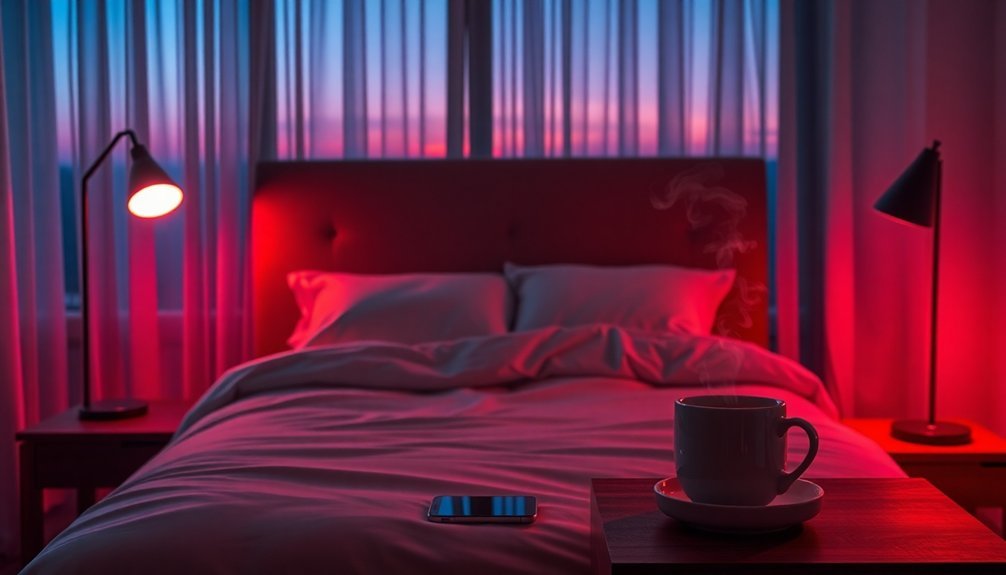
Your evening lighting choices play a vital role in achieving quality sleep. If you're looking to improve your sleep quality, incorporating red light exposure into your evening routine can considerably impact your body's natural sleep-wake cycle.
Start your red light exposure in the early evening hours, as timing is essential for optimal results. You'll want to avoid using red light in the morning since it can interfere with your body's natural response to sunlight.
A consistent exposure of moderate intensity 75 lx will help optimize your therapy results. Instead, focus on consistent evening exposure to help regulate your internal clock and stimulate melatonin production, the hormone that makes you sleepy.
Set up your red light exposure about 2-3 hours before bedtime, but remember to switch it off when you actually go to sleep. While red light doesn't disrupt sleep like blue light does, complete darkness is still best for overnight rest.
You can maximize benefits by combining red light exposure with other relaxation techniques, such as reading or gentle stretching. During this time, you'll also want to minimize exposure to bright overhead lights and blue light from electronic devices, which can counteract the sleep-promoting effects of your red light therapy.
Create Evening Wind-Down Rituals
A well-structured wind-down ritual can transform your evening routine into a powerful sleep enhancer. Start by gradually lowering your lights about two hours before bedtime, switching to warm, low-wattage lighting that signals your body it's time to wind down.
Begin your ritual with gentle physical activities like stretching or yoga to release tension, followed by a warm bath or shower. The temperature drop after bathing naturally prepares your body for sleep. Consider enjoying a cup of herbal tea or warm milk as these beverages contain natural sleep-promoting properties.
Then, engage in calming practices such as diaphragmatic breathing or progressive muscle relaxation to activate your body's natural relaxation response.
You'll find additional benefits by incorporating mindful activities into your routine. Try journaling to clear your mind, creating tomorrow's to-do list to prevent bedtime worry, or spending quality time with loved ones.
If you prefer, practice meditation or yoga nidra to deepen your relaxation.
Remember to maintain consistency with your chosen activities. Your body responds best to regular patterns, so stick to the same sequence each night.
Avoid stimulants during this time, and create a calm environment with soothing music or nature sounds to support your shift into restful sleep.
Optimize Bedroom Light Settings
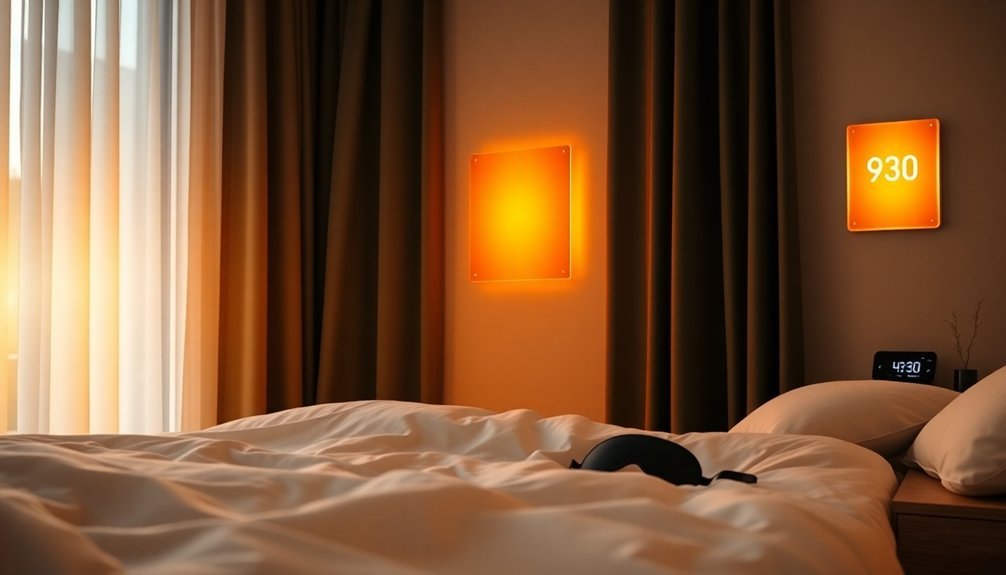
You'll get the best sleep by gradually lowering your bedroom lights about two hours before bedtime, mimicking the natural sunset and signaling your body to produce melatonin.
The gentle transition helps maintain your natural circadian rhythm balance, allowing your body's internal clock to properly regulate sleep and wake cycles.
Installing blackout curtains or shades creates the perfect dark environment needed for quality sleep, blocking out disruptive street lights and early morning sun.
While complete darkness is ideal, if you need some light, opt for warm, amber-colored bulbs at their dimmest setting to maintain your body's natural sleep rhythm.
Dim Lights Gradually Evening
Proper light management during evening hours plays a crucial role in achieving quality sleep. You'll want to start dimming your lights about an hour before bedtime, as this gradual reduction signals your body to prepare for rest.
This practice supports your natural melatonin production and helps maintain a healthy circadian rhythm. Street light exposure through windows can disrupt your sleep quality, so consider installing blackout curtains.
When selecting evening lighting, opt for warm-colored bulbs with temperatures below 3000K. Red, amber, yellow, and orange lights are your best choices as they mirror natural sunset colors and won't interfere with your sleep hormones.
Install dimmable bulbs in your bedroom and living areas to create the perfect ambiance for winding down.
You'll need to be particularly mindful of blue light exposure. Turn on night mode for your electronic devices, or better yet, avoid screens entirely for two hours before bed. If you must use devices, consider wearing blue-light blocking glasses.
Create a consistent evening routine by dimming lights at the same time each night, helping your body recognize when it's time to sleep.
For the most relaxing environment, use warm, dim lighting or flameless candles while preparing for bed.
Master Blackout Window Solutions
While managing indoor lighting sets the stage for better sleep, creating complete darkness in your bedroom requires strategic window treatments. Blackout solutions can block up to 99% of external light while improving your sleep quality and energy efficiency. The proper installation of blackout window treatments can help reduce your energy costs by up to 25% through better insulation.
You'll find various options to match your needs, from roller shades with side channels to motorized curtains that provide both elegance and functionality.
To maximize the effectiveness of your blackout window treatments, consider these proven solutions:
- Install layered window treatments by combining blackout curtains with cellular shades for enhanced light blocking and temperature control.
- Choose roller shades with side channels to eliminate light leakage around the edges of your windows.
- Opt for blackout EZ window covers when you need a temporary or removable solution that provides 100% darkness.
- Select motorized tracks for convenient operation and precise light control.
Remember to customize your solution based on your window type and room layout. Whether you have skylights, bay windows, or standard frames, you'll find suitable mounting options to achieve the most favourable darkness.
Schedule Digital Device Boundaries
Digital boundaries serve as a crucial defense against poor sleep quality in today's screen-dominated world. To protect your sleep, you'll need to establish clear rules around your device usage, particularly in the evening hours.
Start by implementing a "tech timeout" at least one hour before your intended bedtime, giving your brain the break it needs to prepare for rest. Studies show that problematic internet use has the strongest negative impact on sleep quality compared to other forms of electronic media.
When you can't avoid screens in the evening, make sure you're using blue light filters on your devices or wearing specialized glasses that block blue light emissions. These measures help prevent the suppression of melatonin, your body's natural sleep hormone.
You'll also want to designate your bedroom as a tech-free sanctuary by removing TVs, computers, and other electronic devices.
Set up a charging station outside your bedroom and enable "Do Not Disturb" mode on your devices to prevent sleep disruptions from notifications.
Replace your pre-bed screen time with calming activities like reading or taking a bath.
Plan Evening Meal Timing
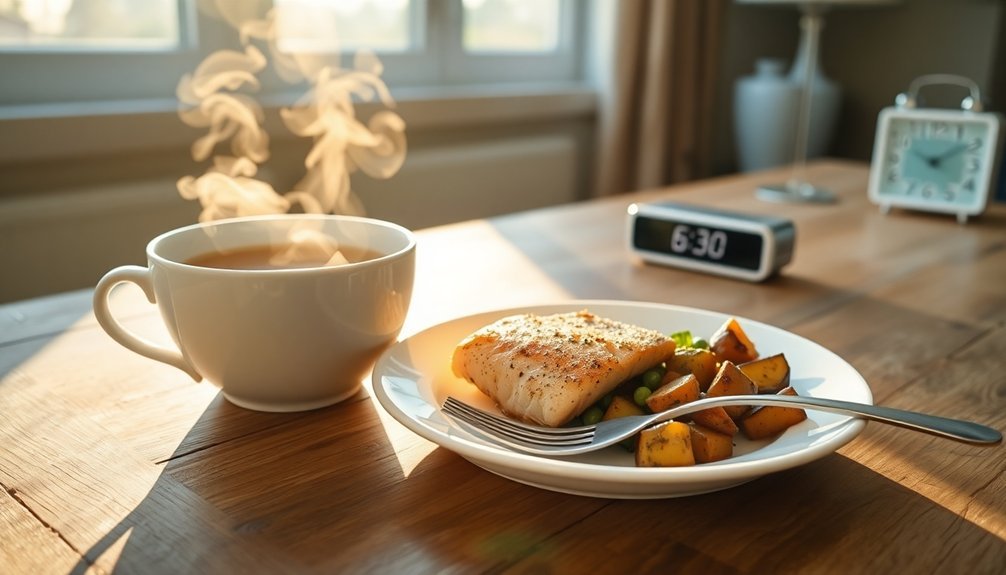
Beyond managing your screen time, your evening meal schedule plays a powerful role in sleep quality. Research shows that when you eat your last meal substantially impacts how well you'll sleep that night.
Your body's food clock and sleep clock work together, making consistent meal timing essential for restful sleep. Studies indicate that higher stress levels are commonly reported among people who eat at irregular times.
To optimize your evening meal timing for better sleep, follow these evidence-based guidelines:
- Schedule your dinner 2-3 hours before bedtime to give your body enough time to digest properly and shift into sleep mode
- Avoid heavy meals in the evening, as they force your body to focus on digestion rather than preparing for rest
- Skip late-night snacking, which can disrupt your circadian rhythm and lead to more nighttime awakenings
- Choose lighter, high-GI meals for dinner when eating four hours before bed to reduce sleep onset time
Set Temperature For Sleep
Setting the right bedroom temperature is one of the most essential factors for quality sleep. Your body naturally lowers its temperature as part of the sleep process, and a cool room helps facilitate this natural cycle.
The ideal sleeping temperature is around 65°F (18.3°C), though you can comfortably sleep in a range between 65-68°F (15.6-20°C). The natural drop in core body temperature begins approximately two hours before bedtime when melatonin is released.
You'll want to adjust your bedroom temperature seasonally, aiming for 16-18°C in winter and 18-20°C in summer. If you're sleeping in a room that's too warm, you're likely to experience restlessness and potentially face cardiovascular stress, even if you don't consciously notice it. Humid heat is particularly problematic as it interferes with your body's ability to regulate temperature through sweating.
To optimize your bedroom temperature, turn down your thermostat before bedtime and reduce heat buildup during the day. Consider using cooling bedding materials and guarantee proper ventilation in your room. You can use air conditioning, fans, or heaters to maintain the right temperature, but remember that individual preferences may vary slightly within the recommended range.
Choose Relaxing Physical Activities
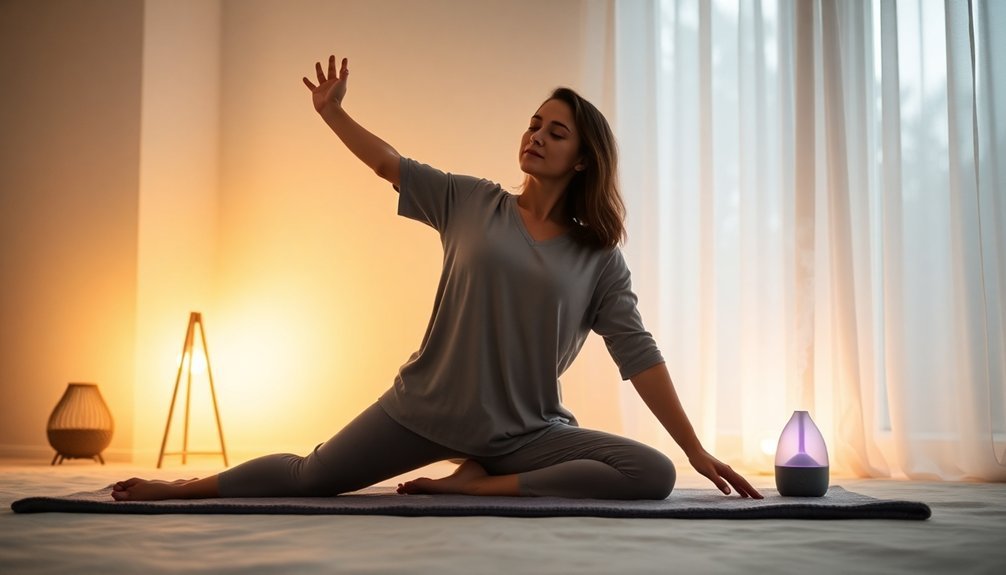
Carefully selecting the right physical activities before bedtime can substantially impact your sleep quality. To prepare your body for rest, you'll want to focus on gentle, low-impact exercises that promote relaxation without causing overstimulation.
Incorporate activities like stretching, light yoga, or a calm evening walk at least 4-8 hours before bedtime.
For the best results, dedicate 10 minutes to gentle stretching exercises targeting major muscle groups, which can help reduce muscle tension and improve blood flow.
Consider implementing these proven relaxation techniques into your evening routine:
- Practice diaphragmatic breathing exercises to activate your body's natural relaxation response and reduce stress levels.
- Try yoga poses such as child's pose, seated forward fold, or supine twist to release physical tension.
- Engage in progressive muscle relaxation by systematically tensing and relaxing different muscle groups.
- Follow stretching with calming activities like reading, completing a puzzle, or journaling.
Remember to allow time for a proper cool-down period after any physical activity. This helps your body shift naturally into a more restful state, preparing you for quality sleep.
Design Your Sleep Environment
Creating an ideal sleep environment plays a vital role in achieving restful nights. Your bedroom's lighting, temperature, noise level, and overall comfort directly impact your sleep quality, so it's essential to optimize each element.
Start by managing your bedroom's lighting. Install blackout curtains to block external light, and switch to red light bulbs in the evening to support your natural sleep-wake cycle. You'll want to avoid blue light from screens and devices before bedtime, as they can disrupt your melatonin production.
Keep your bedroom temperature between 60 to 67 degrees Fahrenheit, with 65 degrees being ideal for most people. Ensure proper ventilation through an open window or air purifier.
To minimize noise disruptions, use white noise machines or fans, and position your bed away from shared walls and street-facing windows.
Don't overlook the importance of comfort. Choose a supportive mattress and comfortable bedding that suits your temperature preferences. Keep your space clutter-free and consider adding calming scents like lavender.
Following these guidelines will transform your bedroom into a sleep sanctuary that promotes quality rest and rejuvenation.
Manage Evening Stress Levels
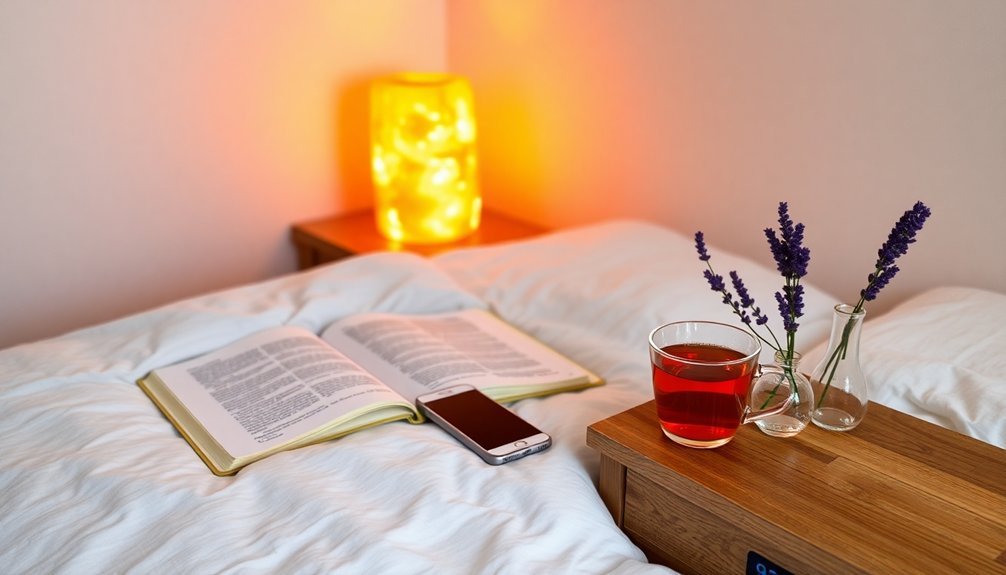
Managing your evening stress levels directly impacts your sleep quality, and you'll find significant benefits in practicing mindfulness techniques like deep breathing or meditation before bed.
You can release physical tension through gentle movement practices such as light stretching or bedtime yoga, which help shift your body from daytime activity to rest mode.
Setting clear boundaries around quiet time in the evening, including a digital detox period and engaging in calming activities like reading or journaling, helps your mind and body prepare for restorative sleep.
Evening Mindfulness Practices
As your day winds down, incorporating mindfulness practices into your evening routine can substantially reduce stress levels and prepare your mind for restful sleep.
Progressive muscle relaxation and body scan meditation work together to release physical tension, while gratitude reflection shifts your focus from daily worries to positive experiences.
You'll find the most benefit by establishing a consistent pre-sleep mindfulness routine that includes visualization and soundscape meditation. Choose calming scenes or sounds that resonate with you, whether it's waves lapping at a shore or the gentle rustling of leaves in a forest. When your mind wanders, gently guide it back to your chosen focus.
- Start with a 10-minute body scan, moving from your toes to your head, acknowledging sensations without judgment
- Practice deep breathing exercises while visualizing a peaceful scene
- Spend 5 minutes reflecting on three things you're grateful for from your day
- End with progressive muscle relaxation, tensing and releasing each muscle group
Remember to maintain a technology-free environment during these practices, as screen exposure can interfere with your body's natural sleep signals. Regular practice will help train your mind to shift more easily into sleep mode.
Stress-Release Through Movement
Physical movement offers a powerful pathway to release accumulated stress before bedtime, combining gentle exercises with mindful breathing techniques. You'll find particular benefit in practices like yoga, tai chi, and qigong, which blend soft movements with controlled breathing to activate your body's natural relaxation response.
To effectively release tension, try incorporating progressive muscle relaxation, where you'll systematically tense and relax different muscle groups. This technique, combined with deep breathing exercises like the 4-7-8 method, can substantially reduce physical and mental stress before sleep.
Don't overlook the value of simple stretching routines or a brief evening walk to decompress from your day. However, avoid vigorous exercise close to bedtime, as it might interfere with your sleep cycle.
Instead, focus on gentle, mindful movements that prepare your body for rest.
You can enhance these movement practices by creating a consistent evening routine. Consider combining them with other relaxation techniques, such as a warm bath or calming music.
Remember to disconnect from electronic devices during these activities, allowing your body and mind to shift naturally into a more restful state.
Quiet Time Boundaries
Establishing clear boundaries for evening quiet time forms the foundation of a restful night's sleep. By creating consistent rules and a calming environment, you'll help your body and mind shift smoothly into sleep mode.
Set your quiet time at the same hour each evening, and maintain a cool room temperature between 65-68°F while dimming the lights to signal your body it's time to wind down.
To maximize your quiet time effectiveness, follow these essential guidelines:
- Create a dedicated quiet space free from electronics, equipped with comfortable pillows and blankets for ideal relaxation.
- Set a specific duration for your quiet time, ranging from 20 minutes to 2 hours, depending on your schedule and needs.
- Use room-darkening shades and consider earplugs to minimize external disturbances.
- Allow yourself to rest without the pressure of falling asleep – relaxation is mandatory, but sleep is optional.
Remember to gradually shift into quiet time by starting with shorter periods and extending them as needed. If you find yourself dozing off, adjust your bedtime accordingly to maintain a healthy sleep schedule.
Time Your Light Therapy
Timing your light therapy correctly can make a significant difference in its effectiveness for improving sleep quality. If you're trying to shift your sleep schedule earlier, you'll want to use light therapy in the morning. Conversely, evening light therapy can help delay your sleep-wake rhythm if you're naturally falling asleep too early.
For best results, use your light therapy device consistently at the same time each day. If you're using a high-intensity light box (10,000 lux), aim for 20-minute sessions. For lower-intensity devices (2,500 lux), you'll need longer sessions of up to two hours.
Keep in mind that you don't need to look directly at the light source – position it slightly to the side while reading or working to prevent eye strain.
Watch for any side effects like headaches or nausea, and adjust your exposure time or distance from the light source accordingly. Remember to complement your light therapy with proper darkness at night and limited blue light exposure from electronic devices.
You should start seeing improvements in your sleep quality within a few days to weeks, but consistency is key for maintaining these benefits.
Frequently Asked Questions
How Do Seasonal Changes Affect Sleep Quality and Evening Routines?
You'll experience shorter sleep during longer summer days and longer sleep in winter. Seasonal light changes affect your melatonin levels and REM sleep patterns, so you should adjust your bedtime routine accordingly.
Can Certain Indoor Plants in the Bedroom Improve Sleep Quality?
Yes, you'll sleep better with bedroom plants like peace lily and snake plant. They'll purify your air, create a calming environment, and some varieties like lavender and jasmine offer soothing scents for improved rest.
What Role Does Bedding Material and Thread Count Play in Sleep?
Your bedding's material and thread count directly impact sleep quality. You'll sleep better with breathable fabrics like cotton and linen, while higher thread counts (400-800) provide extra softness and comfort.
How Do Sleep Patterns Differ Between Night Owls and Morning People?
You'll notice night owls have longer circadian rhythms and later body temperature peaks than morning people. Your sleep-wake cycle differs too – if you're a night owl, you naturally stay up later and wake later.
Does Sleeping With Pets Impact the Quality of Night Rest?
Your pet's presence can both help and hinder sleep. While they'll provide comfort and emotional support, their movements and noises might disrupt your rest. Consider your pet's behavior before sharing your bed.
In Summary
You've got all the tools needed to transform your nights and revolutionize your sleep quality. Start by implementing just one or two of these evening habits, then gradually add more as they become routine. When you're consistent with these practices, you'll notice improved sleep, better morning energy, and an overall enhanced quality of life. Remember, great sleep doesn't just happen – it's crafted through intentional habits.

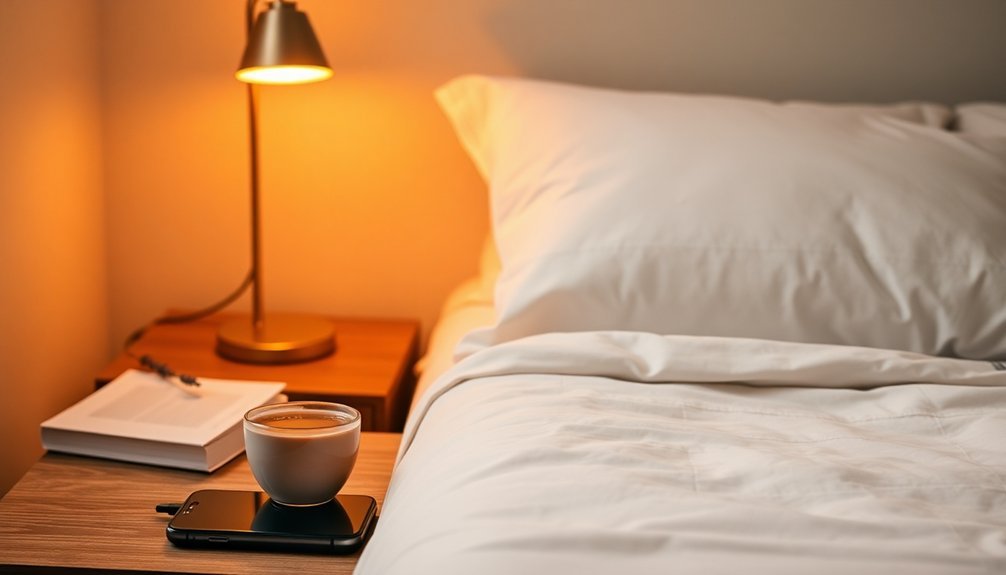



Leave a Reply